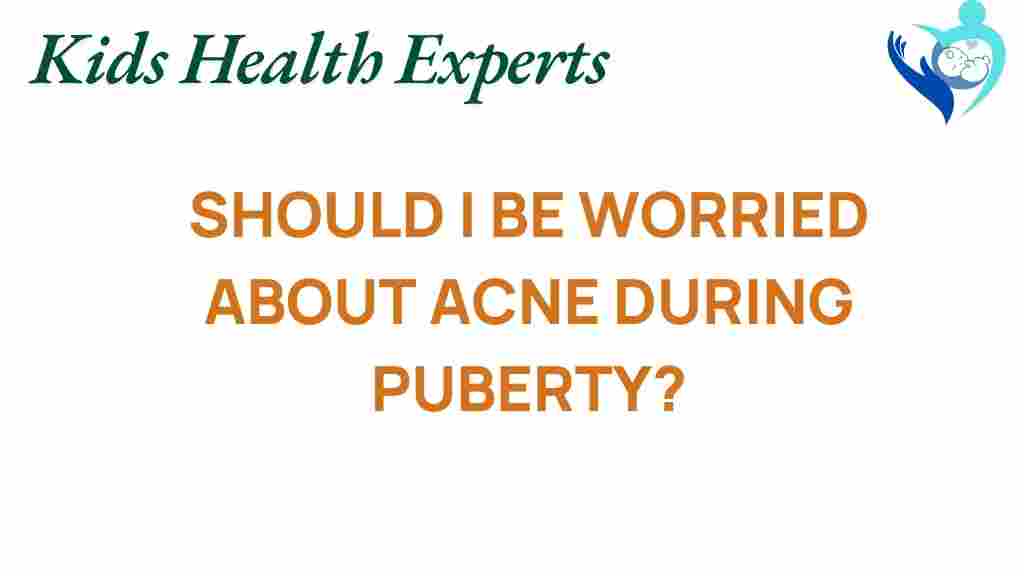Unraveling the Truth: Should You Worry About Acne During Puberty?
Acne is a common skin condition that affects many teenagers during puberty. As hormonal changes trigger increased oil production in the skin, this can lead to breakouts, blackheads, and other skin concerns. Understanding the relationship between acne, puberty, and skin health is crucial for teenagers and their parents. In this article, we will explore the causes of acne during puberty, discuss various teenage skincare routines, and look into treatment options while emphasizing the importance of self-esteem and dermatology.
Understanding Acne and Its Causes During Puberty
Acne is primarily caused by a combination of factors, particularly during puberty when hormonal changes are at their peak. Here are the main contributors:
- Hormonal Changes: During puberty, the body produces more androgens, which can enlarge sebaceous (oil) glands and increase oil production.
- Clogged Pores: Excess oil and dead skin cells can clog pores, leading to acne. Bacteria can also thrive in these clogged areas.
- Inflammation: The body’s immune response to bacteria can cause inflammation, leading to red, swollen pimples.
- Diet and Lifestyle: Certain foods, stress, and lack of sleep can exacerbate acne symptoms.
Recognizing these causes can help in managing and treating acne effectively.
The Impact of Acne on Self-Esteem
Acne can significantly affect a teenager’s self-esteem. Many teens feel self-conscious about their skin, which can lead to:
- Social Anxiety: Fear of judgment from peers can cause teenagers to withdraw from social interactions.
- Depression: Persistent skin issues can contribute to feelings of sadness and low self-worth.
- Body Image Issues: Acne can lead to negative body image, impacting overall mental health.
It is essential to address not only the physical aspects of acne but also its psychological impacts. Encouragement and support from family and friends can help boost a teenager’s confidence during this challenging time.
Teenage Skincare: Building a Routine
Implementing a basic skincare routine can significantly improve skin health during puberty. Here’s a step-by-step guide:
Step 1: Cleansing
Choose a gentle cleanser that is suitable for acne-prone skin. Look for products containing:
- Salicylic Acid: Helps to exfoliate and unclog pores.
- Benzoyl Peroxide: Reduces bacteria on the skin and helps to prevent breakouts.
Step 2: Toning
Toners can help to remove any leftover impurities and balance the skin’s pH. Opt for alcohol-free formulas to avoid drying out the skin.
Step 3: Moisturizing
Even oily skin needs moisture. Use a non-comedogenic moisturizer that won’t clog pores.
Step 4: Sun Protection
Always apply a broad-spectrum sunscreen with at least SPF 30 during the day to protect the skin from UV damage.
Step 5: Spot Treatment
For existing breakouts, consider spot treatments that contain benzoyl peroxide or salicylic acid to target acne directly.
Diet and Lifestyle: Their Role in Acne Management
A healthy diet and lifestyle choices can have a significant impact on skin health. Here are some tips:
- Hydration: Drink plenty of water to keep your skin hydrated and flush out toxins.
- Balanced Diet: Eat a diet rich in fruits, vegetables, whole grains, and lean proteins. Avoid excessive sugar and processed foods.
- Regular Exercise: Exercise helps improve circulation, reduce stress, and promote healthy skin.
- Sleep: Aim for 7-9 hours of sleep each night to allow your body to repair and rejuvenate.
Treatment Options for Acne
If over-the-counter products and lifestyle changes don’t yield results, it may be time to consult a dermatologist for further treatment options. Here are some common treatments:
- Topical Treatments: Prescription-strength topical medications may include retinoids, antibiotics, or stronger formulations of benzoyl peroxide.
- Oral Medications: Antibiotics or hormonal treatments (like birth control pills) may be prescribed to help manage acne.
- Light and Laser Therapies: These treatments target the bacteria that cause acne and can help reduce inflammation.
- Chemical Peels: A dermatologist can perform chemical peels to exfoliate and improve skin texture.
It is important to follow the guidance of a healthcare professional and find a treatment plan that works best for your skin.
Troubleshooting Tips for Acne Management
Managing acne can sometimes be a trial-and-error process. Here are some troubleshooting tips:
- Be Consistent: Stick to your skincare routine for at least six weeks to see results.
- Avoid Picking: Picking at acne can lead to scarring and further breakouts.
- Keep Hair Clean: Oil and products from hair can transfer to the skin, contributing to breakouts.
- Review Your Products: Make sure that all skincare and cosmetic products are labeled non-comedogenic.
If you notice any adverse reactions or if your acne worsens, consult with a dermatologist for further advice.
When to Seek Professional Help
While mild acne is generally manageable at home, there are times when seeking professional help is essential. Consider consulting a dermatologist if:
- The acne is severe and causing painful cysts.
- Over-the-counter treatments have not worked after several weeks.
- Acne is leading to significant emotional distress or impacting daily life.
Dermatologists can offer specialized treatment plans tailored to individual needs and skin types.
Conclusion: Embracing Skin Health During Puberty
Acne during puberty is a common experience, and while it can be distressing, it is essential to understand that it often resolves with time. By adopting a proper skincare routine, making healthy lifestyle choices, and seeking professional help when necessary, teenagers can effectively manage acne and maintain their skin health. Remember, the journey to clear skin is not just about the physical aspects but also about nurturing self-esteem and confidence. Embrace this phase and seek support from trusted friends, family, and professionals to navigate through these challenging years.
For more information on teenage skincare and treatments, visit this resource. And if you’re looking for specific product recommendations, check out this guide.
This article is in the category Conditions and created by KidsHealthExperts Team
